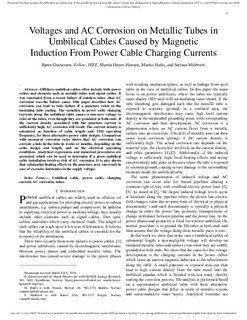| dc.contributor.author | Gustavsen, Bjørn Alfred | |
| dc.contributor.author | Høyer-Hansen, Martin | |
| dc.contributor.author | Hatlo, Marius | |
| dc.contributor.author | Midttveit, Steinar | |
| dc.date.accessioned | 2018-12-07T14:02:13Z | |
| dc.date.available | 2018-12-07T14:02:13Z | |
| dc.date.created | 2018-12-03T08:18:20Z | |
| dc.date.issued | 2018 | |
| dc.identifier.issn | 0885-8977 | |
| dc.identifier.uri | http://hdl.handle.net/11250/2576652 | |
| dc.description.abstract | Offshore umbilical cables often include both power cables and elements such as metallic tubes and signal cables. It was concluded from a recent failure of stainless tubes that AC corrosion was the failure cause. This paper describes how AC corrosion can lead to tube failure if a puncture exists in the insulating tube coating. The variation in power cable charging currents along the umbilical cable causes a non-zero voltage to exist on the tubes, even though they are grounded at both ends. If the current density associated with the puncture current is sufficiently high, AC corrosion will result. The current density is calculated as function of cable length and VSD operating frequency, for three alternative power cable designs. Comparison with measured corrosion rates shows that AC corrosion can corrode a hole in the tube in weeks or months, depending on the cable design and length, and on the electrical operating conditions. Analytical expressions and numerical procedures are presented which can be used to determine if a given umbilical cable installation involves risk of AC corrosion. It is also shown that substantial heating effects in the puncture area can result in case of excessive harmonics in the supply voltage. | nb_NO |
| dc.description.abstract | Voltages and AC Corrosion on Metallic Tubes in Umbilical Cables Caused by Magnetic Induction From Power Cable charging Currents | nb_NO |
| dc.language.iso | eng | nb_NO |
| dc.publisher | IEEE | nb_NO |
| dc.rights | Navngivelse 4.0 Internasjonal | * |
| dc.rights.uri | http://creativecommons.org/licenses/by/4.0/deed.no | * |
| dc.title | Voltages and AC Corrosion on Metallic Tubes in Umbilical Cables Caused by Magnetic Induction From Power Cable charging Currents | nb_NO |
| dc.type | Journal article | nb_NO |
| dc.type | Peer reviewed | nb_NO |
| dc.description.version | acceptedVersion | nb_NO |
| dc.source.journal | IEEE Transactions on Power Delivery | nb_NO |
| dc.identifier.doi | 10.1109/TPWRD.2018.2881221 | |
| dc.identifier.cristin | 1638241 | |
| dc.relation.project | Norges forskningsråd: 256507 | nb_NO |
| cristin.unitcode | 7548,50,0,0 | |
| cristin.unitname | Energisystemer | |
| cristin.ispublished | true | |
| cristin.fulltext | postprint | |
| cristin.qualitycode | 2 | |

